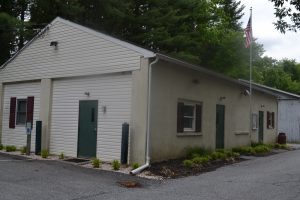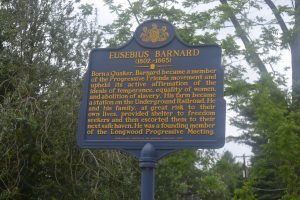In the early 1800s, the Eusebius Barnard House, a Chester County historic landmark, served as a station for escaping slaves in the Underground Railroad movement; more recently, it has served as a source of contention in Pocopson Township.

The township assumed ownership of the house and its surrounding 68 acres from the county in 2008 with the goal of preserving it – an initiative that would create a township building and public meeting space as well as house the Kennett Underground Railroad Museum.
But the path to that repurposing has encountered periodic obstacles for the impassioned members of the Barnard House Steering Committee. Most of the hurdles have focused on finances, according to information discussed at the committee’s meeting on Thursday, May 28.
A number of committee members expressed frustration that the township’s board of supervisors had twice tabled the next step in the project: the Phase Two Scope of Work, which would focus on the interior and pave the way for soliciting bids. The exterior is 90 percent complete, said Richard Jensen, the township’s code enforcement officer, who is also serving as the project manager.
The committee plans a half-hour Power-Point presentation for the next supervisors’ meeting on Monday, June 8, when the Barnard House will appear on the agenda again. It will explain “how we got here and how we’re going to go forward,” said Supervisor Georgia Brutscher, who chairs the steering committee.
During previous supervisors’ meetings, Brutscher favored approving the next phase; however, Supervisors’ Chairman Barney Leonard and Supervisor Ricki Stumpo both expressed concerns about whether the interior layout met the township’s needs for space, function, and security.
At the board’s April 13 meeting, Brutscher responded to her colleagues’ comments by suggesting a meeting with the project’s architect, Dennis Melton of Melton Architects, so that he could address those topics. Melton attended the April 27 meeting and urged the supervisors to approve the Phase Two Scope of Work, but Stumpo and Leonard said they wanted the issues they had raised resolved first. Since the board did not hear back from Melton before the May 11 meeting, a vote on the second phase of work got tabled again.

Melton, who attended the committee meeting last week, said he believed that the issues of workflow and security could be resolved easily. “Are there compromises to be made?” he asked. “Yes, but they’re fairly minor.”
He said it was unfortunate that the work had to be done in stages for financial reasons, which also caused the project to be scaled back. Some of the grants the committee hoped to acquire dried up during the recession, and some of the work, such as restoring the windows, had to be eliminated after determining that one window would require $4,500.
In a May 12 letter urging the supervisors to move forward with the project, Melton detailed more than 30 steps required for phase two, such as finalizing “a detailed scope of work,” selecting contractors, revising the space utilization, and participating in the final punch list. His proposal caps the cost for that work at $13,000. Township records show that since 2009, Melton has received about $100,000 for the project.
Originally, plans called for an addition to the building that was also deemed too expensive and placed on hold. Steering committee member Alta Hoffman said it was unfortunate that costs have been an issue. “Do you know how many millionaires we have in this township?” she asked.
Despite that, some residents have expressed fears that the renovations could become a black hole for the township. Township records show that $728,977 has been spent on the project to date. Subtracting $226,320 in grants and donations brings the township’s net cost to $502,657. Pocopson has budgeted $825,000 in projected costs for 2015, the bulk of which would cover a loan.
The negative feedback has distressed the steering committee members, who said residents have no idea how much work has gone into the project and how many other potential sites for a township building were exhausted. The opportunity to preserve a significant historic structure and transform it into a signature building that will engender community pride represents a double win for the township, they said.
“It’s the right thing to do,” said Brutscher.
Committee member Jean Conary agreed, noting that the current township building, which is basically a garage, doesn’t meet the township’s needs. “I just think this is part of the soul of this community,” she said of the Barnard House.
Lauressa McNemar, another committee member, questioned why a small group of residents is trying to derail the project at the 11th hour. “Someone wants to stop the wheels,” she said. Brutscher noted that “a lot of untruths went out” during the primary election campaign.
Sean Rafferty, a longtime township resident who attended the Barnard House Steering Committee meeting last week, said he believes the historic building “should be used to honor those who helped African Americans escape the horrible conditions that existed in the South.”
But he said he is also seeking “fiscal responsibility” and expressed concern that the committee is trying to advance the project without sufficient feasibility planning. He pointed out that two recent outside studies suggested that the layout of the building doesn’t match the township’s administrative needs.
One study, which analyzed the township’s internal operations, can be viewed on the township’s web site at http://www.pocopson.org/wp-content/uploads/2015/05/Pocopson-Township-Organizational-Analysis-2015.pdf. It was conducted by the Meyner Center for the Study of State & Local Government of Lafayette College.
The other was prepared by Grace Sagnor, a space-planner for Rubinstein’s, an office supply store in West Chester, who recommended keeping the township offices in the current space and using the first floor of Barnard House for meetings and the museum.
“Why is the board talking about Phase Two when two recent and separate studies confirmed that the Barnard House is not a proper township building?” Rafferty asked after the meeting. “Feasibility studies are usually done before a project commences, not at the end.”
Brutscher disputes the notion that the project wasn’t thoroughly researched. “This was a thought-through process,” she said.
She added that she believes residents will support the project when they see the progress that’s been made. She said she hoped residents would come to the meeting on June 8 at 7:30 p.m. in the township building.
Rafferty, a GOP committeeman, said numerous conversations with voters at the polls earlier this month suggested that many township residents share his misgivings. “If this project is so popular as the board promotes it to be, then there should be no problem with obtaining enough votes from the taxpayers to move forward with it,” he said, advocating a referendum.
Brutscher said she hoped the many residents who had voiced support for the project since the committee first elicited feedback in October 2009 would attend Monday night’s meeting, and she expressed hope that those with reservations about it would come with an open mind.
“I think the meeting will be an educational opportunity that will address a lot of questions and quell fears,” she said.



 (8 votes, average: 3.63 out of 5)
(8 votes, average: 3.63 out of 5)
Mr. Melton, you should know what you are saying before you speak. “Some of the work, such as restoring the windows, had to be eliminated after determining that one window would require $4,500.” This was not eliminated the supervisors approved window repairs at $5,000 a pop. Look at their minutes and financial records.
Ms. Hoffman, if their are so many millionaires in the township, why don’t you go solicit them for the funds to renovate this money pit? Could it be they are not in favor of it?
Ms. Conray, you need to read the professional studies the township has done. The Barnard House does not does not meet the township’s needs either.
Ms. McNemar, I think you are mistaken. There are only a small group of residents in favor of the project. There is not a small group of residents trying to derail the project at the 11th hour, the majority of the residents have never been in favor of the project.
Ms. Brutscher, if it is the right thing to do, why can’t you get the other supervisors on board with you? Why can’t you provide the proof it was a thought-through process? Where is the research you claimed was done on the option of renovating the current facility? What untruths were discussed during the primary? The fact the residents don’t want to waste any more money. That’s a truth and if you believe differently, put your money where your mouth is and put it out for referendum like Mr. Rafferty suggests. What do you have to lose? All you will gain is the truth!
Township records show that $728,977 has been spent on the Barnard House Project to date! The Barnard House Committee and supervisors better be able to explain to the public where all that money went and why it is still not useable for a Township Building. In October of 2012 Supervisors told the residents the renovations proposed budget was no more than $750,000-800,000.
The Committee should also provide how many other sites were reviewed for a new facility for the township. If they did the work, where are the studies and cost analysis? You can’t get them through the “Public Right to Know”. Is that because they were never done? Any supervisor past or present that authorized careless spending on this project should be prepared to justify why you wasted tax payers’ money.